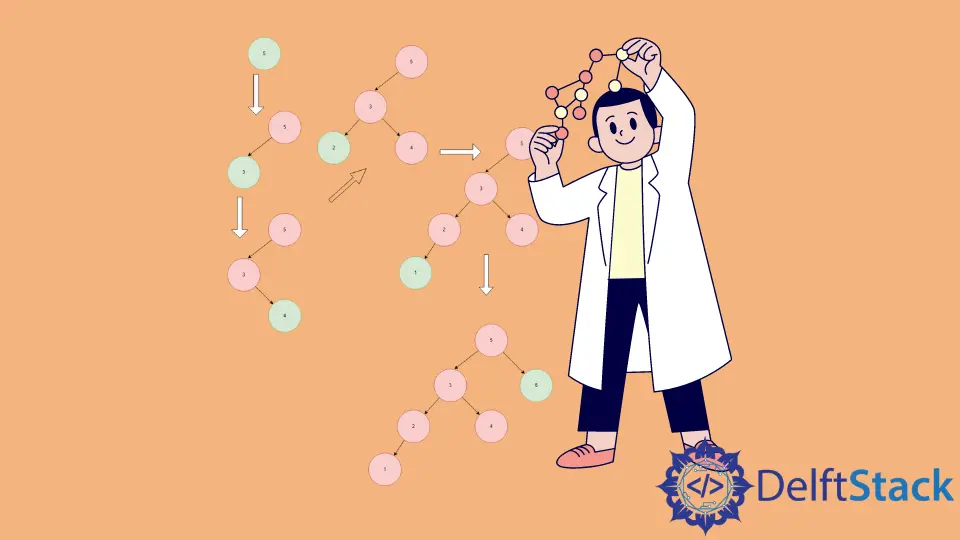Binary Search Tree Iterative Insert
- BST Iterative Insert Algorithm
- BST Iterative Insert Illustration
- BST Iterative Insert Implementation
- BST Iterative Insert Algorithm Complexity

In the previous article Binary Search Tree, we discussed the recursive approach to insert a node in BST. In this post, we will discuss the iterative approach to insert a node in BST. It is better than the recursive method as no extra space is required by the iterative insertion algorithm.
BST Iterative Insert Algorithm
Let root be the root node of BST and key be the element we want to insert.
-
Create the node to be inserted -
toinsert. -
Initialize two pointers,
currpointing torootandprevpointing to null. (currtraverses the tree andprevmaintain its trail). -
While
curr!=NULL, do the following:- Update
prevto becurrto maintain its trail. - if
curr->data>key, setcurrto becurr->left, discard the right subtree. - if
curr->data<key, setcurrto becurr->right, discard the left subtree.
- Update
-
If
prev==NULL, it means that the tree is empty. Create therootnode. -
Else if
prev->data>keythen inserttoinsertin the left ofprev,prev->left=toinsert. -
Else if
prev->data<keythen inserttoinsertin the right ofprev,prev->right=toinsert.
BST Iterative Insert Illustration
-
First, we initialize BST by creating a
rootnode and insert5in it. -
3is smaller than5so it gets inserted into the left of5. -
4is smaller than5but large than3, so it gets inserted into the right of3but left of4. -
2is the smallest element in the current tree, so it gets inserted at the leftmost position. -
1is the smallest element in the current tree, so it gets inserted at the leftmost position. -
6is the largest element in the current tree, so it gets inserted at the rightmost position.
This is how we insert elements inside a BST.
BST Iterative Insert Implementation
#include <iostream>
using namespace std;
class Node {
public:
int key;
Node *left, *right;
};
Node *newNode(int item) {
Node *temp = new Node;
temp->key = item;
temp->left = temp->right = NULL;
return temp;
}
void inorder(Node *root) {
if (root != NULL) {
inorder(root->left);
cout << root->key << " ";
inorder(root->right);
}
}
void insert(Node *&root, int key) {
Node *toinsert = newNode(key);
Node *curr = root;
Node *prev = NULL;
while (curr != NULL) {
prev = curr;
if (key < curr->key)
curr = curr->left;
else
curr = curr->right;
}
if (prev == NULL) {
prev = toinsert;
root = prev;
}
else if (key < prev->key)
prev->left = toinsert;
else
prev->right = toinsert;
}
int main() {
Node *root = NULL;
insert(root, 5);
insert(root, 3);
insert(root, 8);
insert(root, 6);
insert(root, 4);
insert(root, 2);
insert(root, 1);
insert(root, 7);
inorder(root);
}
BST Iterative Insert Algorithm Complexity
Time Complexity
- Average Case
On average-case, the time complexity of inserting a node in a BST is of the order of height of binary search tree. On average, the height of a BST is O(logn). It occurs when the BST formed is a balanced BST. Hence the time complexity is of the order of [Big Theta]: O(logn).
- Best Case
The best-case occurs when the tree is a balanced BST. The best-case time complexity of insertion is of the order of O(logn). It is the same as average-case time complexity.
- Worst-Case
In the worst-case, we might have to traverse from root to the deepest leaf node, i.e., the whole height h of the tree. If the tree is unbalanced, i.e., it is skewed, the tree’s height may become n, and hence the worst-case time complexity of both insert and search operation is O(n).
Space Complexity
The iterative insert operation’s space complexity is O(1) because no extra space is required.
Harshit Jindal has done his Bachelors in Computer Science Engineering(2021) from DTU. He has always been a problem solver and now turned that into his profession. Currently working at M365 Cloud Security team(Torus) on Cloud Security Services and Datacenter Buildout Automation.
LinkedInRelated Article - Data Structure
- Circular Doubly Linked List
- Circular Linked List
- Doubly Linked List
- Linked List Deletion
- Linked List Insertion
- Linked List Merge Sort
Related Article - Binary Tree
- Convert Binary Tree to Binary Search Tree
- Binary Search Tree Check
- Binary Search Tree Inorder Succesor
- Binary Tree Traversal
- Binary Search Tree
- Binary Search Tree Delete

